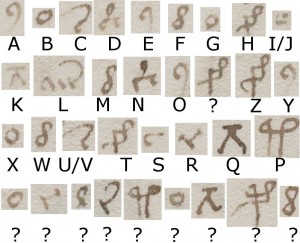Back in January, I predicted that 2008 would be “the year of the Voynich” – not that it would get solved (don’t be so ridiculous, tcha!), but rather that we would be engulfed in a semi-tsunami of Voynich-related fiction, a novelistic response to the VMs meme as it seeps into mainstream culture. And this wave has indeed hit the shore: my big fat list of Voynich novels lists five new titles for the year (plus a couple of others held over until 2009) as well as a rerelease of Max MacCoy’s 1994 Indiana Jones / Voynich book.
And so to the latest one, William “Baz” Cunningham’s just-released third novel “The Voynich Enigma“. For connoisseurs of the genre, this runs on eerily familiar rails: the hero stumbles across a key to the Voynich Manuscript, eventually discovers that it encodes some kind of treasure map (in this case, to the much-speculated-upon Templar hoard), battles against someone else racing for the same treasure (in this case, an evil Mamluk), and so forth. I’m sure You Get The General Idea.
I also have to flag straight off that this is self-publishing at its most “self-“: the author inserts into his narrative a thinly fictionalized version of, errrm, himself (though changing his nickname from “Baz” to “Bones” ), his cousin, his wife, his dog, etc. Perhaps some passing Eng. Lit. grad student will let us know the correct academic name for such faux-autobiographical works (might it be “biographique”?): certainly, it takes the phrase “identifying with the hero” onto a whole new level.
Cunningham’s writing is a bit “Tom Sawyer, Detective” meets Simon Singh, a little bit like hominy grits festooned with lumps of historical meat. But for all the homespun backyardiness, it does have an undeniable charm that makes the 300+ pages an easy read. Mercifully, it is free of overblown Hollywoodesque fights and bad sex scenes, even if prizes are at stake nowadays (one gets the feeling Mrs Cunningham would not have been impressed).
It’s true that the book’s only joke – that, yes, college-educated Americans can actually be smart sometimes – does wear a tad thin by the end. And that its history research does often tend to the superficial. And that the historical dialogue is occasionally too modern-sounding for purists. And that Roger Bacon really, truly didn’t create the VMs (Cunningham relied mainly on Levitov’s book). But for all that, it’s perfectly OK.
Even classifying it as a “novel” rather misses the point: it is closer to some kind of Cunningham family pipedream, thin tendrils of historical smoke above a West Virginia farmhouse coiling together to form a novel-like shape in the still air: it’s a hopeful fantasy, blending past, present, and future into a home-cooked dish du jour.
Oddly, “The Voynich Enigma” most reminds me of Filarete’s libro architettonico. Back in 1465, the Italian architect Filarete concocted a strange ad hoc mélange of autobiography, architecture, fiction, and fantasy to try to promote himself to powerful patrons: without book distributors looking to its back cover for a helpful shelving genre to slot his book into, he was free to say just what he wanted, and in whatever way he wanted. To me, what links Filarete and Cunningham across the five centuries is simply an idiosyncratic self-publishing idealism, that really isn’t about the launch party, the PR, the film options, the points above the line, the Frankfurt & London circus, or even the making money.
Perhaps, ultimately, the Voynich Manuscript itself will turn out to be just as idealistic, a document whose hidden treasure will simply be what it says about its author – the ultimate piece of self-publishing, with a print-run of one. 🙂
